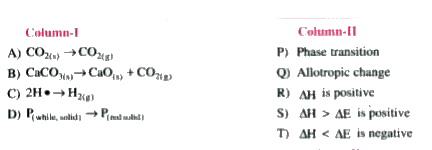Heat of formation of 2 moles of NH3(g) is−90kJl bond energies of H-H and N-H bonds are 435 kJ and 390kJmol−1 respectively. The value of the bond energy of N≡N is (1000−(x2+x+25)) kJ/mol What is x ?Solution in Telugu
The correct Answer is:6
From the data we can say that heat if formation of NH3 is -45 kJ
So, 12N2(g)+32H2(g)→NH2(g),ΔH=−45kJ
So, −45=32(H−H)+12(N≡N)−3(N−H)
32(435)+12(N≡N)−3(390)
N≡N=945 From the given condition
945=1000−(x2+x+25)
So, x2−x+25=55, On solving x = 6s
Topper's Solved these Questions
- CHEMICAL THERMODYNAMICSBOOK - AAKASH SERIESCHAPTER - CHEMICAL THERMODYNAMICSEXERCISE - PRACTICE SHEET (EXERCISE- III) (LEVEL- I (MAIN) STRAIGHT OBJECTIVE TYPE QUESTIONS)
17 Videos
- CHEMICAL THERMODYNAMICSBOOK - AAKASH SERIESCHAPTER - CHEMICAL THERMODYNAMICSEXERCISE - PRACTICE SHEET (EXERCISE- III) (LEVEL- II (ADVANCED) (STRAIGHT OBEJCETIVE TYPE QUESTIONS)
9 Videos
- CHEMICAL THERMODYNAMICSBOOK - AAKASH SERIESCHAPTER - CHEMICAL THERMODYNAMICSEXERCISE - PRACTICE SHEET (EXERCISE- II) (LEVEL- II (ADVANCED) MATRIX MATCHING TYPE QUESTIONS)
2 Videos
- CHEMICAL THERMODYANMICS BOOK - AAKASH SERIESCHAPTER - CHEMICAL THERMODYANMICS EXERCISE - Questions For Descriptive Answers
28 Videos
- ELECTRON MIGRATION EFFECTS BOOK - AAKASH SERIESCHAPTER - ELECTRON MIGRATION EFFECTS EXERCISE - QUESTIONS FOR DESCRIPTIVE ANSWERS
10 Videos
Similar Questions
The least random state of H2O system is
View SolutionWhich has maximum entropy change of vaporisation?
View SolutionMatch the following columns

View SolutionHow does heat of neutralisation value change with the chemical nature of acid and base?
View SolutionHyperconjugation effect is also termed as 'no bond resonance'. Why?
View SolutionHeat of formation of 2mol of NH3(g) is =90kJ, bond energies of H−H and N−H bonds are 435kJ and 390kJmol−1, respectively. The value of the bond enegry of N≡N will be
View SolutionGiven that the food energies of :N≡N is 946kJ mol−1 , H-H is 435 kJ mol−1,N−N is 159 kJ mol−1, and N-H is 389 kJ mol−1 , the heat of formation of hydrazine in the phase in kJ mol−1 is :
View SolutionBond energies of H−HandCl−Cl are 430 kJ mol−1 and 242 kJ mol−1 respectively. ΔHf for HCl is 91 kJ mol−1.
What will be the bond energy of H−Cl?
View SolutionEnthalpy of formation of NH3 is -X kJ and ΔHH−H, ΔHN−H are respectively Y kJmol−1 and Z kjmol−1. The value of ΔHN=Nis
View SolutionHeat of formation of 2 moles of NH3(g) is−90kJl bond energies of H-H and N-H bonds are 435 kJ and 390kJmol−1 respectively. The value of the bond energy of N≡N is (1000−(x2+x+25)) kJ/mol What is x ?
View SolutionH - H एवं Cl - Cl की बंध ऊर्जाएँ क्रमश: 430 kJ mol−1 एवं 242 kJ mol−1 हैं। HCl के लिए ΔHf, 91 kJ mol−1 है, तो H-Cl की बंध ऊर्जा क्या होगी?
View SolutionBond energies of H−HandCl−Cl are 430 kJ mol−1 and 242 kJ mol−1 respectively. ΔHf for HCl is 91 kJ mol−1.
What will be the bond energy of H−Cl?
View SolutionThe H-H bond energy is 430 kJ mol−1 and Cl-Cl bond energy is 240 kJmol−1. △H for HCl is -90 kJ. The H-Cl bond energy is about:
View SolutionThe bond energies of H - H and I - I bonds are 435 kJ mol^-1 and 150 kJ mol^-1 respectively. If DeltaH_f^o for HI is 26.5 kJ mol^-1 then bond enthalpy of H-I bond is
View SolutionThe bond energies of H-H and l - I bonds are 435 kJ mol−1 and 150kJmol−1 respectively. If δHOt for Hl is 26.5 kJ mol−1 then bond enthalpy of H−l bond is
View Solution
